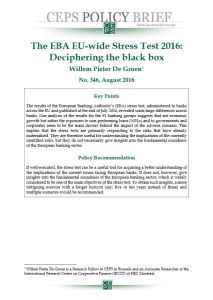Join getAbstract to access the summary!

Join getAbstract to access the summary!
Willem Pieter De Groen
The EBA EU-Wide Stress Test 2016
Deciphering the Black Box
CEPS, 2016
What's inside?
Bank stress tests fail to gauge the overall soundness of Europe’s banking sector.
Recommendation
European banks are diverse and engage in different forms of risk-taking, so assessing their fundamental stability is no easy task. Researcher Willem Pieter De Groen finds that the current European Banking Authority stress test offers greater insights into existing problems, such as nonperforming loans and corporate and government debt exposures, than into banks’ underlying soundness and risk resilience. getAbstract recommends this scholarly analysis – written more for the banker, economist and regulator than the layperson – for its cogent arguments in favor of a more robust methodology for bank stress testing.
Summary
About the Author
Willem Pieter De Groen is a research fellow at the Center for European Policy Studies.

















Comment on this summary